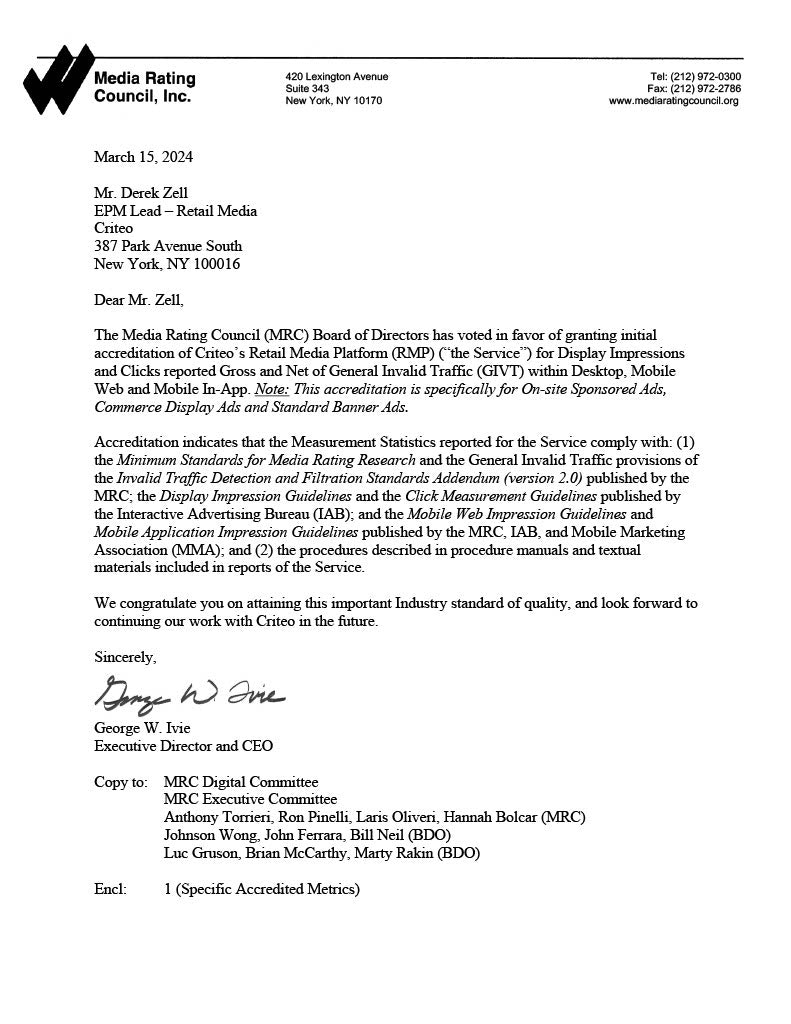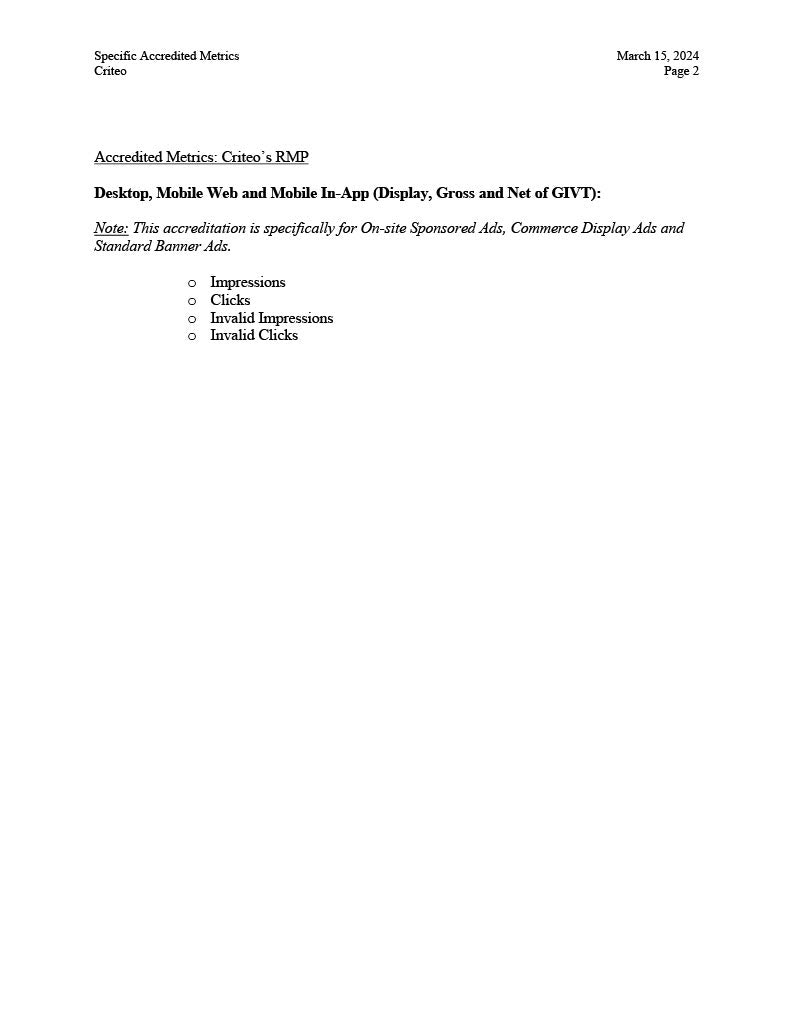

What is MRC Accreditation?
The Media Rating Council (MRC) accredits measurement systems that comply with the standards outlined in the IAB/MRC Guidelines. Criteo’s accreditation certifies that its methodologies for counting clicks and impressions in Commerce Max adhere to these guidelines. Currently, the certification covers onsite ad measurement only.
Why it matters?
Validates that Criteo’s measurement systems follow industry best practices.
Ensures transparency and accountability in click and impression reporting.
Allows advertisers to trust that invalid traffic (IVT) is identified and excluded.
Who is it for?
Advertisers using Commerce Max for onsite campaigns.
When to use it?
When verifying click and impression billing accuracy.
During audits, compliance checks, or client reviews.
When measuring campaign performance quality using IVT data.
How it works?
MRC Accreditation Audit Process
The Media Rating Council (MRC) accreditation certifies that Criteo’s Commerce Max click and impression measurement systems adhere to IAB/MRC Guidelines for counting ad clicks and impressions. You can view our certification letter attached.
At this time, the MRC Certification for Criteo’s Retail Media Platform does not include impressions or clicks associated with off-site or video campaigns. These formats are scheduled to be part of Criteo’s future phases of accreditation.
For additional information on these standards and guidelines, please visit the IAB/MRC Guidelines.
Partner Qualification
Criteo maintains Supply Partner Guidelines (https://www.criteo.com/supply-partner-guidelines/) and Advertiser Guidelines (https://www.criteo.com/advertising-guidelines/) to ensure high-quality supply and demand networks. Advertisers must have their products on the Retailer's site to serve ads through Commerce Max. While Criteo relies on the Retailer to implement functionality, Criteo conducts thorough tests to ensure complete integrations and implementations.
Filtration Methodology
Criteo uses various methods to identify and filter out invalid click and impression traffic, which can be non-human or human. We use data from the Interactive Advertising Bureau (IAB) and Trustworthy Accountability Group (TAG) to detect non-human traffic. Criteo also blocks traffic from employee accounts, internal testing accounts, and internal IP addresses. The filtering rules are reviewed quarterly by an internal committee and adjusted as needed. Advertisers can view excluded Invalid Clicks in the Analytics tab of Commerce Max.
If a new type of invalid traffic is discovered, Criteo will conduct a backward-looking analysis to see if previously reported data was significantly affected. If the data was materially impacted, clients will be notified, and steps will be taken to resolve any issues.
The Criteo Engineering Team updates the filtration methods at a quarterly review cycle in addition to real-time updates if issues are uncovered or new standards are needed. The filtration methods are as follows:
Decision Rate: Criteo traffic receives significant information to apply a 100% invalid traffic decision rate on activity.
Multiple-click-per-impression: Criteo limits billable clicks to 2 clicks per ad impression on ads generated from Commerce Max. This includes a lookback window of 30 minutes after the initial impression. Any clicks outside the limit are no longer considered valid and are excluded from billing.
Click staleness: A click is considered invalid if the time between the ad impression and the click is more than the impression-staleness window. These invalid clicks are no longer considered valid and are excluded from billing.
User Frequency Capping: Criteo will limit the frequency of all ads (across advertisers) that can be served to specific users. The frequency caps employed are proprietary and not disclosed.
Upfront Filtration: Criteo leverages upfront filtration to detect invalid traffic and exclude it. Upfront filtration techniques include industry-standard techniques like blocklists from endpoints deemed risky.
IAB/ABCe International Spiders & Robots List: The IAB/ABCe International Spiders & Robots List is used to identify and remove community-known bots.
Activity-Based Filtration: Criteo tracks user events and activity frequency to determine commercial intent and invalidates traffic (both impressions and clicks) that fails to meet a minimum level of quality as assessed through these techniques.
Click measurement methodology
Criteo Retail Media uses the “In-Unit Click” reporting methodology for measurement. According to the IAB Measurement Guidelines (https://www.iab.com/wp-content/uploads/2015/06/click-measurement-guidelines2009.pdf), this type of click “represents measurement of user-initiated actions on Advertisements, but, in contrast to a 'click' or 'click-through', an in-unit click does not lead to a redirect from the publisher”. Retail Media clicks can take the user to another page on the Publisher site, but do not redirect the user to a different web location.
Impression measurement methodology
Criteo counts an impression when the placement or product is loaded and begins to render on the retailer's page.
Since Criteo ads are native/organic and called by Retailer sites for placement, Criteo relies on the Retailer to implement the necessary beacons according to the appropriate guidelines. However, as an added assurance, Criteo conducts periodic testing to ensure that guidelines are being met. Criteo also maintains specific Supply Partner Guidelines (found here - https://www.criteo.com/supply-partner-guidelines/) to ensure the operation of the highest-quality supply network.
Data Logging, Processing, and Reissuance
Each call to Criteo delivery servers generates a logging event that is processed through the data pipeline and is then stored in the Criteo data warehouse. Criteo validates that all required information is contained in the event. These events are then available in the Commerce Max reporting service.
If Criteo detects issues that impact advertiser spend or data, we follow established investigative and escalation processes to determine the overall impact and potential credits or refunds for advertisers. These are done on a case-by-case basis and are communicated to the impacted advertisers by Criteo’s customer service teams. In these cases, data can be reprocessed to provide correct billing and reporting metrics.
Media Rating Council Invalid Traffic (IVT) Reporting Columns
The Onsite Sponsored Products Activity and Onsite Display Activity reports available on the Analytics tab of Criteo’s Advertiser Platform (CMAX) have been enhanced to view click and impression quality information. For more information, see the tooltips on the report pages. Several columns related to click and impression quality may be added to these reports:
Clicks (Gross) - The number of times your ads were clicked, including suspected invalid traffic.
Clicks (Net) - This metric excludes invalid traffic per GIVT Requirements.
Clicks (Invalid) – Clicks identified as unintentional or fraudulent by our traffic monitoring.
Impressions (Gross) - The number of times your ads were shown, including suspected invalid traffic.
Impressions (Net) - This metric excludes invalid traffic per GIVT Requirements.
Impressions (Invalid) – Impressions identified as unintentional or fraudulent by our traffic monitoring.
Cache-busting techniques
To minimize undercounting due to caching, Criteo Retail Media uses expiry, unique string assignments, and cache-control headers.
Known Limitations
Since Criteo ads are native/organic and called by Retailer sites for placement, Criteo and the Retailer implement the necessary beacons according to the appropriate guidelines. As an added assurance, Criteo also conducts periodic testing to ensure that guidelines are being met. Criteo also maintains specific Supply Partner Guidelines (found here - https://www.criteo.com/supply-partner-guidelines/) to ensure the operation of the highest-quality supply network.

